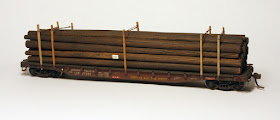I have mentioned in previous posts that in many cases, railroad agents provided local switch crews with written messages to help direct their work. More commonly, I am sure, the communication was simply verbal. With both agent and crew doing the same jobs day after day, even the most abbreviated conversation would readily convey all that needed to be said. But if the agent were not on duty, a written message would substitute.
My first post on this topic was fairly general, about the agent’s role (you can see it at:
http://modelingthesp.blogspot.com/2011/10/operations-role-of-agent.html ), but was followed by something specific about the use of bill boxes for communicating the written messages. The latter post can be viewed at:
http://modelingthesp.blogspot.com/2012/03/bill-box.html , and some prototype agent’s messages were included there. For the case of the SP in particular, I have described the use of blank forms of various kinds by agents for all kinds of messages, especially telegram forms (which by the 1950s were abundant and not often used as intended). That post is at this link:
http://modelingthesp.blogspot.com/2012/08/internal-sp-communications.html .
Waybill preparation has been described in several prior posts, including this one (
http://modelingthesp.blogspot.com/2014/07/waybills-part-33-more-on-role-of-agent.html ), and the waybill of course was part of the communication to switch crews. A conductor stepping into a depot to see the agent would receive fresh waybills for outbound loads which were to be picked up, along with Empty Car Bills for empties to pick up, and the conductor would deliver to the agent waybills for inbound loads the crew was going to spot or had already spotted. What the agent might have to convey verbally or in writing, was where to direct arriving empty cars (which were normally moved with paperwork only identifying a town destination), along with any special instructions, such as refrigerator cars to pre-ice.
My own approach to using these messages was shown in a preliminary way in a post about a practice operating session, which I described in this post:
http://modelingthesp.blogspot.com/2015/04/a-practice-operating-session.html . That practice session was informative for me, and I modified and extended the messages used then, for the full sessions conducted in my “public” sessions that followed. I described those sessions in a post soon afterward. You can find it at:
http://modelingthesp.blogspot.com/2015/05/a-public-operating-session.html .
This post is about the evolved messages I used. Drawing on the prototype messages shown in the earlier posts, I concentrated on identifying empty cars for crews to pick up, empty as well as loaded refrigerator cars needing icing, and any off-spot cars. Waybills for loaded reefers contain icing instructions, but a waybill is not made up until a car is loaded or about to be loaded, so the crew needs direction on icing if needed prior to loading (called “pre-icing”).
Here is the opening message to the crew working Shumala at the beginning of the session.
As mentioned, this is on an SP telegram blank. For ease in reading the content, which may be a little small on the full message (above), here it is by itself.
The font used here, incidentally, is one called “Old Typewriter.”
The empty car directions are not absolutely necessary, as the agent could hand the crew the filled-out Empty Car Bills for these cars, but I noted in reading the prototype messages that in several cases, agents did inform crews this way about empties to pick up. “Initial icing” is the first icing of a car
after loading.
The same kind of message was provided at the start of the session for the crew starting work at Santa Rosalia. For simplicity, I made one message, from the Ballard agent, directing work at both Ballard and Santa Rosalia, but in future I will probably issue separate messages upon crew arrival at the respective depots. Here is the content of that message.
The pattern is much like the Shumala agent’s message, with the addition of a single off-spot car which needed to be spotted. The crew could be handed the waybill for this car when they get the agent’s message.
For both messages, if you wish to figure out what the crew was expected to do, it might be helpful to look at my schematic town maps. The crew had these in the timetables they were issued. Construction of my timetable was described in my
Model Railroad Hobbyist column, October 2014, and in a blog post, at:
http://modelingthesp.blogspot.com/2014/10/my-column-on-timetable-construction.html .
All four crews who operated here told me that the messages were clear and helpful about the “missing information.” The messages supplemented the waybills for loaded cars to deliver, which the crews also had, so those cars are not included in the agent’s messages. There were also cars at various locations which did not need to be moved, and for which crews had no waybill, Empty Car Bill, or mention in the agent’s message, and in that case, the cars were where they were supposed to be, no action required.
I will continue to use, and likely to refine, my agent’s messages for switch crews. It reflects the prototype reality of the role of the agent, and seems to work all right in an operating session.
Tony Thompson






































